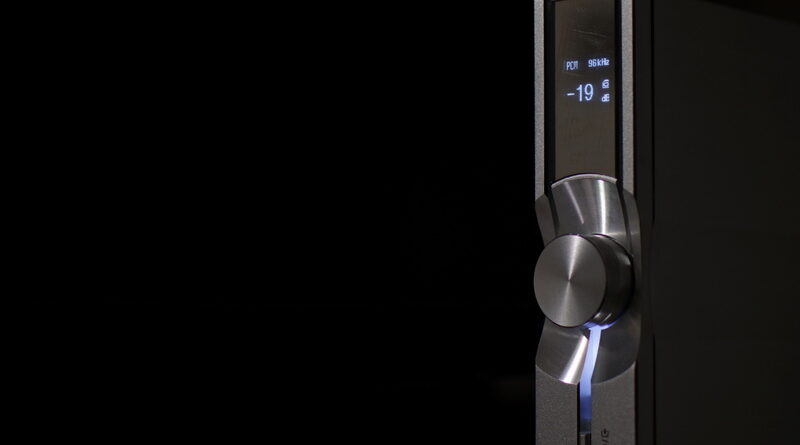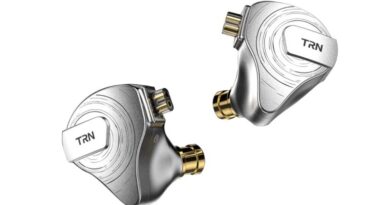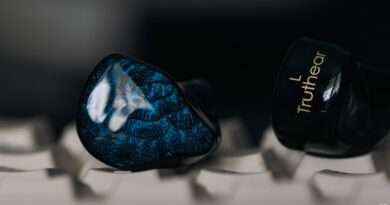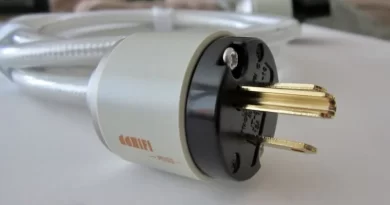iFi Audio Neo iDSD Review – Breaking The Mould
Pros — Excellent industrial design that stands out (not another boring rectangle)
– Small footprint, vertical mount is handy
– DAC performance of Neo iDSD is excellent and comparable to similarly priced DAC-only options
– Excellent BT performance, MQA full decoding, remote is handy
Cons — Buttons on the front haven’t got the best feedback
– Amp section is underwhelming
– Noisy output from headphone out with sensitive IEMs/Headphones (might be fixed via FW upgrade)
In this Article
INTRODUCTION
iFi Audio is on a roll lately with new releases.
First there is the Zen stack. The Hip DAC soon followed, and then came the iDSD Signature. The release of the Neo iDSD, however, was quite sudden as it’s been a while since iFi has released a desktop all-in-one solution.
Nonetheless, iFi refreshing their lineup is definitely a welcome move as they’ve been lacking options in certain price-points. The Neo iDSD aims to fill in the sub-$1000 bracket, and with a list price of 750 euro is definitely targeted towards premium buyers. This market segment is a very competitive one as products both below and above the price range can serve as quite viable options. The Neo iDSD ain’t short of tricks up its sleeve though to stand out.
A lot of ground to cover, let’s get right into it.
This review originally appeared on my blog.
Note: the ratings given will be subjective to the price tier. Karina Dearman of iFi Audio was kind enough to send the iFi Neo iDSD as part of the head-fi review tour. Disclaimer.
Headphones/IEMs used: Sennheiser HD650, Final Sonorous III/E5000, Hifiman Ananda, Dunu Studio SA6/Zen
Price, while reviewed: 750 euros. Can be purchased from Amazon DE.
iFi Neo iDSD: PHYSICAL THINGS AND USABILITY
PACKAGING AND ACCESSORIES
You get quite a few things in the Neo iDSD package. Alongside the usual RCA-to-RCA interconnect and a short USB 3.0 cable you also get a handy remote control (runs on cell battery), an antenna to improve BT reception, a metal stand where you can mount the Neo iDSD in vertical position, a 3.5–to-6.35mm converter, some spare rubber feet, and finally the iPower adapter. It’s definitely a complete accessory package but I have an issue with the super-short USB cable. The RCA-cable is short as well but I usually go for aftermarket RCA cables so that’s not an issue (and most buyers in this range will likely get a third-party one too). The USB 3.0 cable, however, is too short for desktop users. I wish iFi improves this part of the package in future products, esp at mid/upper-mid level pricing.
4/5
BUILD QUALITY
The iFi Audio Neo iDSD looks quite unique and the design is a welcome departure from the boring rectangular boxes you see literally everywhere nowadays. The silver-colored chassis is made out of sandblasted aluminium. There is a solid heft to the unit despite its diminutive size. Speaking of dimensions, the Neo iDSD is on the smaller side vs other DAC/Amps in this price bracket, esp if you orient it vertically. Yes, the Neo iDSD supports both horizontal and vertical orientation and I went with the latter which not only makes it look sleek but also saves desk space.
The front of the unit has the OLED display up-top which is a Silentline OLED, i.e. it doesn’t add any noise to the signal path and shows the current input signal type, sampling rate, volume, and selected input. The display also orients itself accordingly based on the orientation of the unit courtesy of a built-in accelerometer. At the bottom you’ll find the input selector along with the power button, followed by the 4.4mm pentaconn balanced out and the 6.35mm single-ended out. Sandwiched between the display and the buttons are the volume knob (also acts as a navigation wheel incl. push function and has nice tactile bumps when in operation) and a white, diffused LED strip to indicate that the unit is powered up.
Oh, I almost forgot the Hi-Res sticker. Very important.
The back of the unit is where things get more interesting. Everything is labeled already (as you can see in the picture) but just to reiterate: the output can be either RCA-in or two 3-pin XLRs. Also at the very top you can see the antenna screw-in point to improve reception of BT signal. Other than the front and back, the sides of the unit are bereft of any controls or ports. All in all the build quality is excellent. I do have one nitpick: the power/input selector buttons are a bit wobbly. Minor nitpick though. Also ignore the scratch on the display on my unit, that’s how the tour unit arrived and brand new units should be spotless.
5/5
OPERATION
The Neo iDSD can be operated using the supplied remote or the buttons on the front panel. The operation using the buttons is a bit different so it’s best if you check out iFi’s tutorial videos:
Also note that to switch between fixed and variable line-out mode you’d need to restart the DAC while holding down the volume wheel. Weird, I know.
TECH INSIDE
As usual, the specs first:

The iFi Neo iDSD uses a Burr-Brown chip as per tradition. The BT5.0 is one of the highlights of the product and has LDAC support. iFi also uses a new proprietary PureWave topology where they go for a dual-mono setup with shorter signal paths than their previous designs. The default firmware is GTO-enabled by default and iFi also ditched the xBass/3D analog circuits. I am a bit bummed at the omission of the xBass but Neo iDSD aims to be a purist design and those analog DSP effects are anything but purist.
The internal components are all high quality as expected. TDK/Murata caps, FET-based switching to mute those annoying “pops” you encounter on some DAC/Amps, and native MQA full-rendering support. I confirmed the latter by setting up Tidal on Windows in exclusive mode and playing MQA Master files, which were seamlessly handled by the Neo iDSD (indicated by displaying MQA in the OLED display). At this juncture I should mention that it’s advised to install the iFi Neo iDSD driver package if you’re on Windows (Mac version coming soon). You can get it here.
The Bluetooth also works really well. I transmitted music from my Sony Walkman NW-A55 via LDAC without much fuss. iFi has really nailed BT support on this device.
SOUND
AMP PERFORMANCE
The amp section on the Neo iDSD is disappointing from my experience, sadly. The single-ended out is too underpowered and the balanced out, while powerful enough to drive the Sennheiser HD650 and the likes, lack the dynamism you get when these headphones are properly driven. iFi’s own budget Zen Can has far superior amplification for such headphones and when using the Zen Can as an amp with the Neo iDSD the lack of drive on the Neo iDSD is painfully obvious.
Another issue is the noise you get with sensitive IEMs. I’m not entirely sure if this is unit specific or a firmware issue (iFi did issue a FW upgrade to solve this issue but it didn’t improve things on my unit) but a few other reviewers have also experienced it (e.g. Currawong) so I’d advise against driving sensitive IEMs out of the Neo iDSD.
When connected to high impedance/less sensitive headphones/IEMs the output is clean and exhibits a nice smoothness. Things can get too smooth at times if you’ve connected the Neo iDSD to a warm headphone but overall it’s an enjoyable listen, provided that you use something that’s not sensitive to background hiss.
3/5
DAC PERFORMANCE
The iFi Neo iDSD is 50% DAC and 50% Amp on paper, but for my use case — it’s 100% a DAC and a darn good one at that. Heck, it is one of the best DACs out there in the price-bracket, period (more on this in the comparison section). There is no GTO filter here so I was curious how it might sound and as it turns out — the rendition is wonderful. Dynamics are spot on, the soundstage has great depth (albeit less impressive height and width). The best part was the midrange rendition: smooth without losing details and very engaging presentation. The treble isn’t on your face either but has good amount of sparkle and air. Please note that these impressions were made by using Cayin iHA-6 as an amp and then connecting the HD650/Sonorous III. The Neo iDSD was also set up in balanced configuration via the two 3-pin XLR cables.
One area where the Neo iDSD might not suite everyone as a DAC is soundstage width. It’s one of the regions where it falls a bit short. Another area would be the bass, which has great texture but lacks the meatiness some might prefer. For a more balanced, engaging presentation the Neo iDSD does really well, however.
4.5/5
PAIRINGS
I mainly used two amps with the Neo iDSD: the iFi Zen Can and the Cayin iHA-6. The former is a relatively budget offering and provides an upgrade over the built-in amp of the Neo iDSD IMO, esp when powered with iPower X. The Cayin iHA-6, however, took things to the next level. Exceptional layering, stage depth and micro-detail retrieval coupled with great dynamics. Given the ~$1300 price tag for both of these devices combined, I’d say you’re getting comparable performance to other DAC/Amp setups in a similar price-point, though this particular pairing is mostly suited for full-size headphones rather than IEMs (iHA-6 is too powerful for most IEMs due to 7W @ 32ohms rating from the balanced out). For general all-purpose use I think something like the Topping stack (A90/D90) will be more versatile, or perhaps pairing the A90 with the Neo iDSD.
SELECT COMPARISONS
vs Questyle CMA-400i ($800): The Questyle CMA-400i is my daily driver DAC/Amp and shares some similarities with the Neo iDSD. Both got fully balanced architecture, both can be mounted vertically (though the CMA-400i stand is very difficult to find), offers no analog input (to use as an amp alone) and both are using relatively older chipsets without any selectable reconstruction filter options unlike the latest DAC/Amps out there.
The similarities end there though. The CMA-400i is much larger and weighs substantially more, has 2.5mm and 4-pin XLR balanced out unlike the 4.4mm one on the Neo iDSD, and has no display/remote option.
In terms of sound, unlike the Neo iDSD the CMA-400i has a very clean output. Unfortunately selecting the gain mode is cumbersome (you need to push 4 DIP switches at the bottom of the unit to switch gain) but even at high gain sensitive IEMs don’t exhibit as much hiss as the Neo iDSD (and in low gain it’s basically silent). The sonic differences are also quite noticeable. The CMA-400i goes for an airy presentation and displays a high amount of detail. In fact, resolved detail is higher on the CMA-400i than on the Neo iDSD. Depending on headphone though this can get a bit overboard, but I personally like it for my use-case (most of my headphones are warm-ish). Neo iDSD plays it safe on that regard. Both got exemplary stage depth though Neo iDSD edges out the CMA-400i on that regard. CMA-400i hits back with better stage width/height and more impactful bass rendition. Also if you want native MQA the Questyle can’t help you.
As a DAC, the CMA-400i is close to the Neo iDSD, with personal preferences splitting the difference. As an amp though the CMA-400i is clearly better and is more versatile for headphones and IEMs due to less background hiss and better drive (Questyle’s Current Mode Amp is truly exceptional in this regard).
vs Topping D90 ($750): The Topping D90 costs as much as the Neo iDSD but since I’m mostly using the Neo iDSD as a DAC I thought this is an apt comparison. In terms of features the D90 is clearly superior to the A90 with the highest-rated AKM flagship chipset and a very sophisticated UI that allows you to modify the sound in a number of ways. I do prefer the Neo iDSD’s minimalist approach in this regard but those who love to tinker might veer towards the Topping D90.
In terms of sound, the D90 is basically details galore. The stage is much wider and taller, though depth seemed similar. Mids are a bit pushed back on the Topping D90 at the expense of bass and treble presence. In terms of dynamics, I prefer the Neo iDSD though, as the Topping can feel a bit dull and uninspiring. In fact I enjoy listening to the Neo iDSD more than the D90 despite the latter having superior resolution and wider staging.
If you want a more neutral, almost boring presentation I think the D90 can serve you well and provide you with a feature set longer than the constitution. If you want a more engaging presentation though the Neo iDSD is the one I’d recommend.
CONCLUDING REMARKS
The iFi Audio Neo iDSD is a far better DAC than an amp, basically that’s my takeaway after using it for over a month. The amp section leaves a lot to be desired from an all-in-one perspective but the DAC section is excellent and will give even dedicated DACs in this price bracket a run for the money. The BT support is seamless, it looks sleek, and I just love the vertical stand option. iFi broke the mould of making boring rectangular DAC/Amps and offered purist design which I definitely appreciate, though those looking for all the bells and whistles like selectable reconstruction filters or PEQ might have to look elsewhere.
If only the amp was less noisy in the output and had better drive for higher impedance/low-sensitivity cans I could see this one as an endgame DAC/Amp solution for many. Sadly, it’s a bit away from that crown. Perhaps the next one might break through the barrier.
MY VERDICT
3/5
Recommended (for use as a pure DAC, amp section might disappoint)
DISCLAIMER
Note: the ratings given will be subjective to the price tier. Karina Dearman of iFi Audio was kind enough to send the iFi Neo iDSD as part of the head-fi review tour.
Get it from Amazon US/Amazon DE
Our generic standard disclaimer.
PHOTOGRAPHY
You find an INDEX of our most relevant technical articles HERE.










